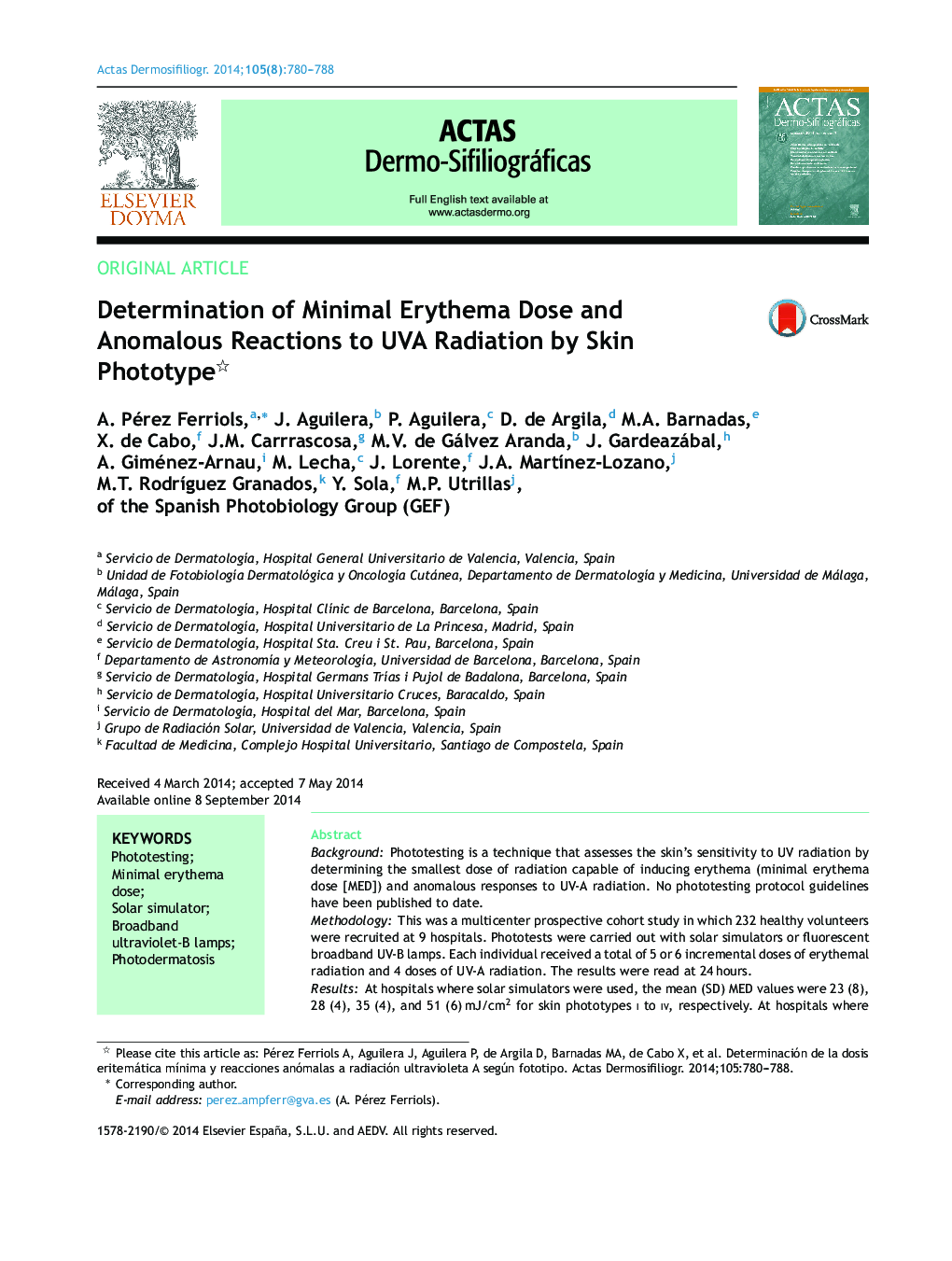| کد مقاله | کد نشریه | سال انتشار | مقاله انگلیسی | نسخه تمام متن |
|---|---|---|---|---|
| 3182421 | 1200653 | 2014 | 9 صفحه PDF | دانلود رایگان |

BackgroundPhototesting is a technique that assesses the skin's sensitivity to UV radiation by determining the smallest dose of radiation capable of inducing erythema (minimal erythema dose [MED]) and anomalous responses to UV-A radiation. No phototesting protocol guidelines have been published to date.MethodologyThis was a multicenter prospective cohort study in which 232 healthy volunteers were recruited at 9 hospitals. Phototests were carried out with solar simulators or fluorescent broadband UV-B lamps. Each individual received a total of 5 or 6 incremental doses of erythemal radiation and 4 doses of UV-A radiation. The results were read at 24 hours.ResultsAt hospitals where solar simulators were used, the mean (SD) MED values were 23 (8), 28 (4), 35 (4), and 51 (6) mJ/cm2 for skin phototypes i to iv, respectively. At hospitals where broadband UV-B lamps were used, these values were 28 (5), 32 (3), and 34 (5) mJ/cm2 for phototypes ii to iv, respectively. MED values lower than 7, 19, 27, and 38 mJ/cm2 obtained with solar simulators were considered to indicate a pathologic response for phototypes i to iv, respectively. MED values lower than 18, 24, and 24 mJ/cm2 obtained with broadband UV-B lamps were considered to indicate a pathologic response for phototypes ii to iv, respectively. No anomalous responses were observed at UV-A radiation doses of up to 20 J/cm2.ConclusionsResults were homogeneous across centers, making it possible to standardize diagnostic phototesting for the various skin phototypes and establish threshold doses that define anomalous responses to UV radiation.
ResumenAntecedentesLa técnica del fototest evalúa la sensibilidad de la piel a la radiación ultravioleta (RUV) mediante la determinación de la mínima dosis de radiación capaz de producir eritema (dosis mínima eritemática [DEM]) y la respuesta anómala a UVA. No existen guías protocolizadas para la técnica del fototest.MetodologíaEstudio multicéntrico de cohortes prospectivo. Un total de 232 voluntarios sanos fueron reclutados en 9 centros hospitalarios. El fototest se realizó con simuladores solares (SS) o lámparas fluorescentes de UVB de banda ancha (UVBBA). Cada sujeto recibió un total de 5 o 6 dosis progresivas de radiación eritemática y 4 dosis de UVA. La lectura se realizó a las 24 h.ResultadosLa DEM media por fototipo fue de 23 ± 8, 28 ± 4, 35 ± 4 y 51 ± 6 mJ/cm2 (fototipos i a iv respectivamente) para los centros que utilizaron SS y de 28 ± 5, 32 ± 3 y 34 ± 5 mJ/cm2 cuando se utilizaron lámparas de UVBBA para fototipos del ii al iv. Se consideraron valores de DEM patológica 7, 19, 27 y 38 mJ/cm2, para los fototipos i al iv respectivamente cuando se emplearon SS y de 18, 24 y 24 mJ/cm2 para los fototipos ii-iv expuestos a lámparas de UVBBA. A dosis de hasta 20 J/cm2 de UVA no se observaron respuestas anómalas.ConclusionesExiste homogeneidad de resultados en los diferentes centros participantes, lo que permite estandarizar el método del fotodiagnóstico para los diferentes fototipos cutáneos, así como establecer las dosis umbral que definen una respuesta anómala a la radiación ultravioleta.
Journal: Actas Dermo-Sifiliográficas (English Edition) - Volume 105, Issue 8, October 2014, Pages 780–788